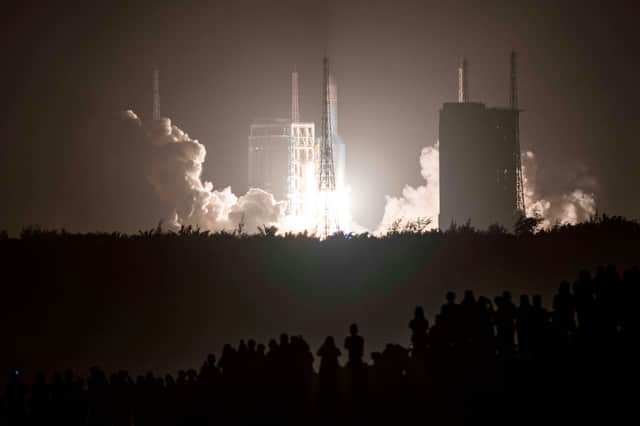'Out of control' Chinese rocket crashed into moon leaving 'unusual' double crater, according to US research


The moon was left with an unusual impact crater after an out-of-control rocket booster crashed. The rocket has now been revealed to be of Chinese origin and was carrying an undisclosed payload, a new study revealed.
The rocket was the Long March 3C rocket booster from China’s Chang’e 5-T1 mission. It had completed several close flybys of the Earth and the Moon in the previous three months, travelling through space at almost 9,600kph (6,000mph) before it crashed and formed a bizarre “double crater”.
Advertisement
Hide AdAdvertisement
Hide AdIt was previously suspected that the object which crash landed on the moon in March 2022 was either debris from a SpaceX Falcon 9 from the DSCOVR mission or from the Chang’e 5-T1 mission. However, researchers from the University of Arizona in the US, who published this study in the Planetary Science Journal, discovered the cause after analysis ruled out the possibility that it was a Falcon 9 booster, and the Chinese government also disputed claims that it was one of their own spacecraft.
Describing what made the impact, and crater left behind, interesting, study co-author Tanner Campbell said: “You would expect it to wobble a little bit, particularly when you consider that the rocket body is a big empty shell with a heavy engine on one side ... But this was just tumbling end over end, in a very stable way.”
The analysis revealed the rocket booster likely had a large mass on the top balancing the two engines at the bottom which weighed nearly 550kg (1,200lbs) each without fuel. But Chinese data disclosed by the government said the two known instruments on the booster only weighed about 27kg, according to Campbell.
After assessing the trajectory and light emissions from the strange object, the team showed "conclusively” what caused the crater. “Our trajectory and spectroscopic analyses using ground-based telescope observations show conclusively that WE0913A is the Chang’e 5-T1 R/B,” they wrote in the study.
Advertisement
Hide AdAdvertisement
Hide AdThe rocket was designed as part of the strategy planned for the country’s 2017 Chang’e 5 lunar sample return attempt which looped around the moon. But American scientists found that the booster went into a highly elliptical orbit with trajectory calculations showing it may have impacted the far side of the Moon.
They found an “additional mass” on the front of the rocket body, suggesting the Chinese spacecraft likely carried an undisclosed payload - or cargo. Nasa’s Lunar Reconnaissance Orbiter (LRO), was used so the researchers could image the crater formed on the moon about 7.5 km from where the probe was predicted to have crash landed.
After comparing images of this moon region taken by the LRO before and after the impact they found two distinct craters were made, “supporting the hypothesis that there was an additional mass on the rocket body”.
“To get those two craters of about the same size, you need two roughly equal masses that are apart from each other. Obviously, we have no idea what it might have been – perhaps some extra support structure, or additional instrumentation, or something else. We probably won’t ever know,” scientists said.
Comment Guidelines
National World encourages reader discussion on our stories. User feedback, insights and back-and-forth exchanges add a rich layer of context to reporting. Please review our Community Guidelines before commenting.
